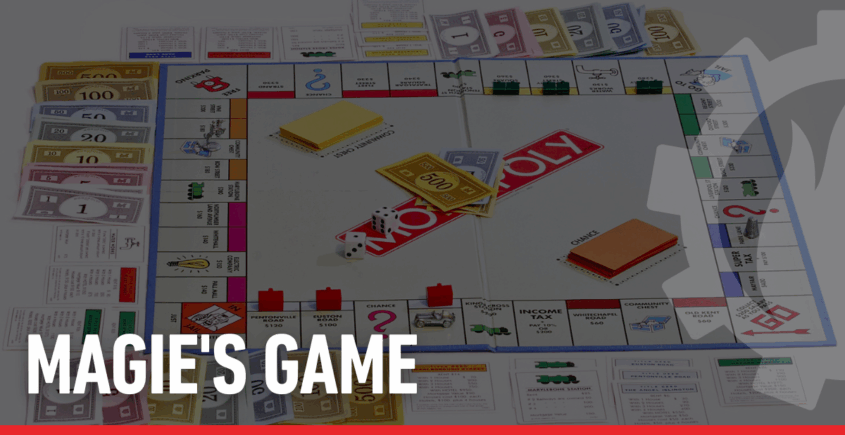Magie’s Game
As we get closer to the holidays, and the fun gift giving, (I love giving gifts, and don’t mind receiving as well!!), I’m always on the prowl for new family games. (If you have any suggestions, please email me @ skowalski@khtheat.com). Hitting the “game” aisle, it’s not uncommon to see so many of the classics – Stratego, Clue, Chutes and Ladders, Uno, Trouble, and of course, Monopoly. For me, Monopoly never gets old – it’s easy to play, fun to strategize a plan, and usually winds up with one person winning most of the money. The grandkids are coming of age to play, and I can’t wait to take their $$- (HA!) After a 10-year hiatus, McDonald’s just brought back their fast-food Monopoly game – of course, with new twists, online registration, instant wins, posts, scans, Facebook chatter, and more. I’ve always associated Monopoly with The Parker Brothers, who went on to really dominate games – they actually offer over 1800 different games. Doing research, I found out the real originator of the Monopoly game was Elizabeth “Lizzie” Magie, who designed her original board game as a critique, not a tribute, to capitalism. Quite a character, she held some contemporary views in her time, but her gaming story is lost a bit to history. I went digging a bit and found the story behind the game. Enjoy!

Here’s some reading and Monopoly playing background music
Lizzie Magie was born in 1866 in Macomb, Illinois. Her father, James Magie, was a keen supporter of Georgism and a great proponent of equality. Traits that were certainly passed down to his daughter.
In 1890 (ish), Magie and her family moved to Washington, DC, where she would find work as a stenographer and typist at the Dead Letter Office. Here, every piece of undeliverable mail was sent to be investigated, sorted, and, ultimately, disposed of. Only the staff at this Office had the power to open mail, and many turned detective to reunite mail and owner.
In her free time, Magie would write poetry and short stories, and would act and perform comedic routines on stage. She also clearly had an aptitude for invention, for in 1893 she was granted US patent no. 498,129 for an improvement she designed for Hammond class typewriters. Her invention reduced the size of the margins on the page, thus allowing for more typed words per page.
Magie would eventually start teaching Georgism in the evenings but quickly became frustrated by her limited reach. By now, single tax proponents were dwindling in America, in large part because the charismatic and well-liked George had passed away. Magie eagerly sought a way to spread her views more widely and soon settled on a board game as the ideal solution.
By the end of 1903, Magie had created a board game titled ‘The Landlord’s Game’, to which US patent no. 748,626 was granted on the 5th January 1904. The game board drawing Magie supplied with her patent showed a square board with rows of squares around the edge. The similarities with Monopoly can clearly be seen.
Some of its notable features are: a continuous path for players to circle over-and over again (most board games at the time had a set path with a clear start and end point), collecting wages for passing the starting point, four railroads, a ‘go to jail’ corner space (complete with a corresponding ‘jail’ corner space), a public park space (a precursor for free parking), property spaces which the players would buy and sell with play money and deed cards, etc.
Originally, the object of the game was to obtain wealth. Magie would later refine the game to have two sets of rules in order to better make her point. A monopolist set (known as Monopoly), in which the goal was to create monopolies and force others out of business, and an anti-monopoly set (known as Prosperity), in which all players were rewarded during wealth creation. Magie believed this approach would demonstrate to the players that the anti-monopoly version was the morally correct choice. Both in-game, and, of course, in the real world. As the rules of the 1932 edition of the game stated:
‘The Landlord’s Game shows why our national housekeeping has gone wrong, and Prosperity Game shows how to start it right and keep it going right.’
In 1906, Magie moved to Chicago, where, along with some friends, she founded the Economic Game Company in order to sell her game. While never really a sales success, copies were sold to college lecturers who used it as a teaching aid (just as Magie hoped). In 1910, Magie submitted the game to Parker Brothers, but they decided against publishing it.
Unbeknownst to Magie, The Landlord’s Game was becoming popular among the college students who had played the game in their economics classes. Copies soon began to spread from friend group to friend group, from locale to locale, in the Northeast of the US. Unfortunately, none of these copies was the version Magie produced. At the time, it was fairly common to create homemade versions of published board games, and this is how The Landlord’s Game spread.
The fact that the board games were homemade meant changes could creep in. Sometimes, new house rules would be added to the ruleset. Other times, the locations on the game board would be fully changed to reflect the local area (something Monopoly would later do itself, to great success).
Unfortunately, the meaning of the game became somewhat lost as people soon realized that it was actually more fun to dominate as a landlord and bankrupt one’s friends and family. So much so that the Prosperity ruleset was eventually left to one side entirely, and so the game became increasingly known as ‘The Monopoly Game’ or just ‘Monopoly’.
In 1932, Charles Todd bumps into his childhood friend, Esther Jones, whilst out on a walk. They had lost touch after leaving their Quaker school, and so made plans to catch up over dinner, along with their spouses. Their friendship was soon renewed, and so Todd would go on to invite Jones and her husband over for a board game night. They played a homemade version of Monopoly, and Jones and her husband, one Charles Darrow, were immediately hooked. Todd would go on to make Darrow his own version of the board game, for which Darrow insisted he provide a clear written set of the rules.
The US was in the middle of the Great Depression, and Darrow had indeed lost his job. Given the circumstances, it’s not my place to judge or question Darrow, but he soon decided to try and sell the game as his own. He asked his friend, the political cartoonist, Franklin F. O.’ Alexander, to work on the design. Some accounts list his contributions as including the now iconic ‘human’ characters seen on the game board. These include Rich Uncle Pennybags, Jake the Jailbird, and Officer Edgar Mallory. It is likely he also designed many of the illustrations that have remained mostly unchanged, such as the tap and light bulb seen on the utility spaces, and the question mark seen on the chance spaces and cards.
Originally, Darrow made his version of Monopoly with a round game board made out of oilcloth. By 1934, he had moved onto a cardboard square board, which was sold at a local department store. He used his initial profits to refine his version further, and after some sales success, the game would go on to be bought by Parker Brothers in 1935. The same year, Darrow and Parker Brothers obtained US Patent no. 2,026,082 for the board game. Monopoly sold 278,000 units in 1935, and in 1936 it sold 1,751,000. The game was an unprecedented success. Soon after the deal with Parker Brothers was made, Darrow was asked by the President of the company for a written account of how he came up with the idea. This is where Darrow told a lie that would go on to be repeated for years to come.
Parker Brothers soon discovered Darrow wasn’t telling the truth and became worried about Magie and her 1924 patent. So, in November of 1935, George Parker himself visited the now 70-year-old Magie. He told her the company had come across her board game and wanted to sell it (along with two other board games she subsequently created). Magie was obviously delighted by the prospect of her board game finally being mass-produced and sold widely, and accepted $500 for her patent. No royalties were offered. Parker Brothers would publish copies of all three games, but soon let them fade away after little advertising.
In 1936, Magie was, of course, shocked to see Monopoly on sale, especially as someone called Darrow was listed as the inventor. She wanted some form of payback and decided to fight back via the press. The story was hardly front-page news and was soon forgotten.
Monopoly went on to be a huge worldwide success, Darrow became the first board game millionaire, and Magie was all but forgotten until the 1970s.
In 1973, Ralph Anspach, an economics professor at San Francisco State University, released a board game designed to teach players about the ills of real-world monopolies. The game was fittingly titled ‘Anti-Monopoly’, and it quickly became a modest counter-culture hit. Predictably, it wasn’t long before the owners of Monopoly sent Anspach a cease and desist letter due to what they considered an infringement on their trademark. Anspach ignored the letter.
During the nearly decade-long legal battle that would follow, Anspach, as part of his defense, would thoroughly examine the history of Monopoly, and everything was uncovered. He was able to prove that the board game had existed for many years before Darrow and found surviving homemade versions of the game from the 1910s and 1920s (several of which even had the words ‘Monopoly’ blazoned across the middle). Anspach eventually won his suit and was allowed to sell his Anti-Monopoly game.
Today, there is plenty of media that details her place in history. Magie is rightfully recognized as being the originator of Monopoly, and as such is considered a leading figure in the development of board games.
So, I gotta know…what is your favorite game piece?? (Can you name all the original pieces?) Email me at skowalski@khtheat.com and I’ll tell you mine.





Leave a Reply
Want to join the discussion?Feel free to contribute!